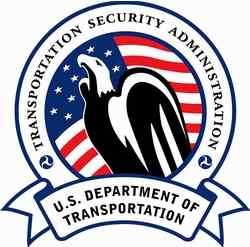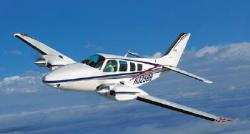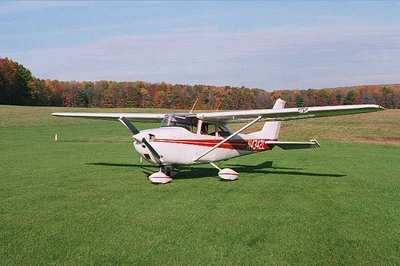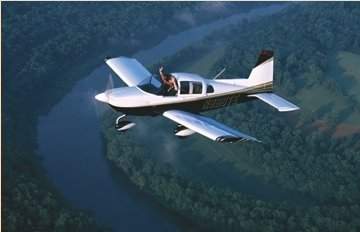Sat, May 03, 2003
Warns Airports To Be On The Lookout
From TSA Advisory 03-019:
This advisory was produced by the Department of Homeland
Security based on information and analysis from the Terrorist
Threat Integration Center received during the last 24
hours.

The Continuing Threat To Aviation
 Al-Qaida has
long considered attacking US Homeland targets using light aircraft.
Recent reliable reporting indicates that al-Qaida was in the late
stages of planning an aerial suicide attack against the US
Consulate in Karachi. Operatives were planning to pack a
small fixed-wing aircraft or helicopter with explosives and crash
it into the consulate. This plot and a similar plot last year
to fly a small explosive-laden aircraft into a US warship in the
Persian Gulf demonstrate al-Qaida’s continued fixation with
using explosive-laden small aircraft in attacks. General
aviation aircraft that were loaded with explosives to enhance their
destructive potential would make them the equivalent of a
medium-sized truck bomb.
Al-Qaida has
long considered attacking US Homeland targets using light aircraft.
Recent reliable reporting indicates that al-Qaida was in the late
stages of planning an aerial suicide attack against the US
Consulate in Karachi. Operatives were planning to pack a
small fixed-wing aircraft or helicopter with explosives and crash
it into the consulate. This plot and a similar plot last year
to fly a small explosive-laden aircraft into a US warship in the
Persian Gulf demonstrate al-Qaida’s continued fixation with
using explosive-laden small aircraft in attacks. General
aviation aircraft that were loaded with explosives to enhance their
destructive potential would make them the equivalent of a
medium-sized truck bomb.
Al-Qaida may attempt to use charter or general aviation aircraft
to conduct future attacks because of their availability, less
stringent protective measures, and destructive potential. The
group has a fair sized pilot cadre and the use of small aircraft
requires far less skill and training than some larger aircraft.

Charter aircraft also may be attractive because terrorists may
only need an established line of credit to gain access to an
aircraft and because some agencies allow the use of customer
pilots. Security procedures typically are not as rigorous as
those for commercial airlines and terrorists would not have to
control a large number of passengers.

Reliable information obtained last year indicated al-Qaida might
use experienced non-Arab pilots to rent three or four light
aircraft under the guise of flying lessons.
In consideration of the above information, the Department of
Homeland Security asks members of the General Aviation community to
report all unusual and suspicious activities. If you observe
persons, aircraft, and operations that do not fit the customary
pattern at your airport, you should immediately advise law
enforcement authorities.
Your immediate action is requested for these items:
- Secure unattended aircraft to prevent unauthorized use.
- Verify the identification of crew and passengers prior to
departure.
- Verify that baggage and cargo are known to the persons on
board.
- Where identification systems are in place, ensure employees
wear proper identification and challenge persons not doing so.
- Increased vigilance should be directed toward the
following:
- Unknown pilots and/or clients for aircraft or helicopter
rentals or charters.
- Unknown service/delivery personnel.
- Aircraft with unusual or unauthorized modifications.
- Persons loitering in the vicinity of aircraft or air operations
areas.
- Persons who appear to be under stress or the control of other
persons.
- Persons whose identification appears altered or
inconsistent.
- Persons loading unusual or unauthorized payload onto
aircraft.
NOTE: All charter operators subjected to the 12-5 rule,
Standard Security Program and the Private Charter Security Program,
are reminded to ensure compliance with these security
requirements.
Persons should immediately report such activity to local law
enforcement and the TSA General Aviation Hotline at 866-GASECUR
(866-427-3287).
More News
Aero Linx: Aviators Code Initiative (ACI) Innovative tools advancing aviation safety and offering a vision of excellence for aviators. The ACI materials are for use by aviation pra>[...]
Make Sure You NEVER Miss A New Story From Aero-News Network Do you ever feel like you never see posts from a certain person or page on Facebook or Instagram? Here’s how you c>[...]
From 2016 (YouTube Edition): Who You Gonna Call When You Have a Rocket Engine that Needs a Spacecraft? While at EAA AirVenture 2016, ANN CEO and Editor-In-Chief, Jim Campbell, sat >[...]
"In my opinion, if this isn't an excessive fine, I don't know what is... The odds are good that we're gonna be seeking review in the United States Supreme Court. So we gotta muster>[...]
Expedite Used by ATC when prompt compliance is required to avoid the development of an imminent situation. Expedite climb/descent normally indicates to a pilot that the approximate>[...]
 ANN's Daily Aero-Linx (04.30.25)
ANN's Daily Aero-Linx (04.30.25) ANN FAQ: Turn On Post Notifications
ANN FAQ: Turn On Post Notifications Classic Aero-TV: Agile Aeros Jeff Greason--Disruptive Aerospace Innovations
Classic Aero-TV: Agile Aeros Jeff Greason--Disruptive Aerospace Innovations Aero-News: Quote of the Day (04.30.25)
Aero-News: Quote of the Day (04.30.25) ANN's Daily Aero-Term (04.30.25): Expedite
ANN's Daily Aero-Term (04.30.25): Expedite






